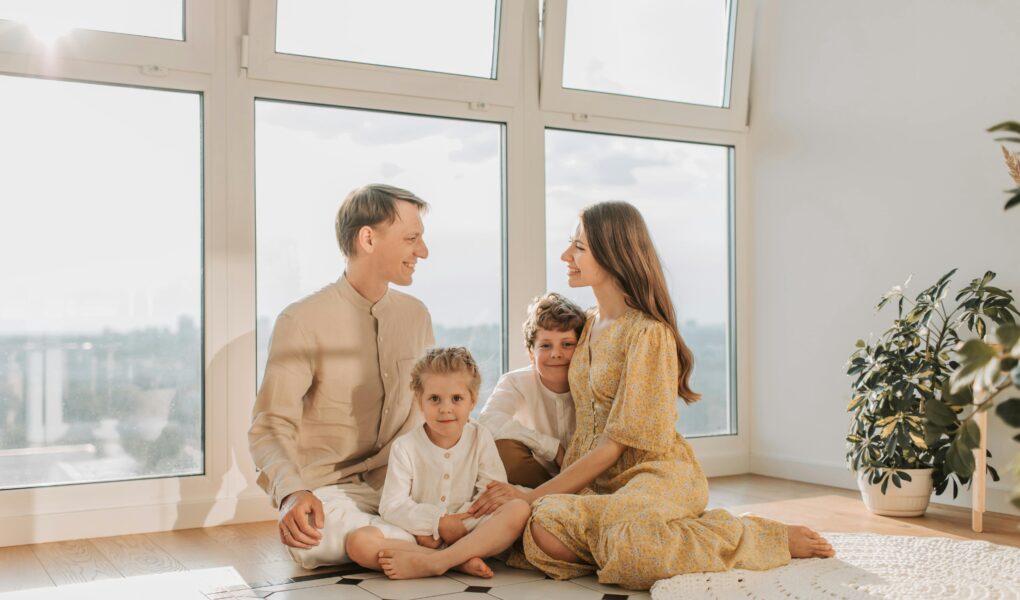Feeling good at home starts with a space that gives comfort, lifts your mood, and feels safe. The colors you pick, the lighting you choose, and even the textures you touch day after day all shape whether your home feels welcoming or cold. A warm and happy home supports better sleep, lowers stress, and makes daily life more enjoyable.
This guide will show quick and practical steps for cozy colors, natural textures, and simple decluttering. There are tips for boosting happiness through lighting, adding natural touches, and making every room feel more personal. Building a warm home isn’t complicated or expensive—it’s about small changes that create big emotional rewards for you and everyone who walks through your door.
The Foundations of a Warm and Happy Home
Feeling secure, understood, and at ease under your own roof is more than just a wish—it’s the starting point for true happiness in daily life. The mood of a home is set by what happens between its walls, not just its furniture or décor. Creating emotional safety, connecting through shared routines, and keeping clutter in check each play a crucial role. Here’s what matters most when it comes to nurturing a home where everyone feels they belong.
Emotional Safety and Open Communication
A warm home starts with a sense of emotional safety. When family members feel supported and heard, the whole atmosphere changes. Building this safe space means making support and presence a part of everyday life.
- Open conversations act as a pressure valve for stress. When everyone knows they can speak their mind—without criticism or judgment—trust grows fast.
- Consistent routines help, too. Knowing what to expect gives both kids and adults a sense of control and stability. This lowers anxiety and brings calm, even during busy or uncertain times.
- When you truly listen, offer understanding, and give comfort in tough moments, you lay the groundwork for resilience and long-term happiness.
Research shows that emotional safety can actually reduce heart rates and lower stress, making home a real sanctuary for every member of the family. For a deeper look at why this matters, see this thoughtful guide on emotional safety and why it’s important.
Family Traditions and Shared Experiences
Memorable traditions and small rituals give families something special to look forward to together. Shared experiences don’t have to be grand. Even simple, repeated activities can build strong ties and a sense of identity.
- Weekly movie nights
- Homemade pizza parties on Fridays
- Holiday breakfasts with a favorite recipe
- Game nights or storytelling sessions
These routines give families anchors—a sense of predictability that is comforting. They also help kids make sense of the world, feel safe, and know they matter. Science backs this up: Family traditions boost connection and happiness, and they can turn even routine days into happy memories.
You might try inventing new family rituals, or simply taking time for collective downtime. By valuing these moments, you show your loved ones that happiness at home isn’t just about the big things—it comes from togetherness in daily life.
Decluttering and Organized Spaces for Calm
Mess and disorder have a real impact on how we feel at home. Piles of clutter can raise stress and sap the mood of even the coziest rooms. An organized space, on the other hand, brings a sense of calm and makes it easier to relax.
 Photo by cottonbro studio
Photo by cottonbro studio
Research from psychologists shows that the more clutter in a home, the lower people rate their life satisfaction and the higher their reported levels of stress. Read more about the psychological impact of clutter.
To start creating an organized home:
- Tackle one area at a time—don’t try to do it all in one day.
- Give everything a home. Use bins, baskets, and shelves for storage.
- Let go of what you don’t need. Donate, recycle, or toss out rarely used items.
- Involve everyone in the process, even kids—they learn by doing.
A calm, organized environment makes everyday routines smoother, invites relaxation, and frees up your mind for better things. For practical tips and more on the mental benefits of an organized space, see these decluttering strategies for mental health.
By building these foundations—emotional safety, family connection, and harmony through organization—you can turn any house into a true home.
Design Elements That Evoke Comfort and Coziness
Our senses shape how we feel at home. From the texture of a throw blanket under your hand to the glow of a lamp at dusk, these details pull us into a state of ease. Thoughtful design can make a house not just look warm, but feel it—welcoming you in and encouraging relaxation at the end of a long day.
Layered Textures and Natural Materials
There’s nothing quite like sinking your toes into a soft rug or curling up with a chunky knit throw. Tactile experiences are central to comfort. Textiles like velvet pillows, fleece blankets, woven baskets, and heavy curtains all invite touch, sending signals of safety and warmth to the brain. Natural materials, such as unfinished wood, stone, rattan, and linen, stir up memories of nature—calm forests or breezy porches. Even seeing these textures can bring on a sense of peace.
Adding greenery, such as potted plants or fresh flowers, introduces gentle movement, clean air, and organic shapes, making any room feel alive. Mix and layer your textures:
- Plush cushions with woven throws
- Wood floors paired with soft area rugs
- Linen or cotton bedding topped with a wool blanket
This approach doesn’t just look good—it encourages you and your guests to settle in and feel at home. For more ideas, see these cozy home interior ideas that make any room feel inviting.
 Photo by Polina ⠀
Photo by Polina ⠀
Lighting: Setting the Mood
Light affects mood more than most realize. Natural light during the day keeps us energized and positive, so opening curtains or choosing sheer fabrics can instantly boost your spirits. In the evening, soft, warm bulbs, candles, and dimmers create a gentle twilight, signalling to your body that it’s time to rest.
Consider these lighting choices for cozy atmospheres:
- Living rooms: Layer different lamps—table lamps, floor lamps, and fairy lights. Use dimmers for flexibility.
- Bedrooms: Choose soft bedside lamps or wall sconces instead of harsh overhead lights.
- Kitchens: Mix task lighting with warm under-cabinet lights for a relaxed glow.
Candles offer ambience and scent, adding another layer of comfort. For modern tips, these cozy interior design ideas offer strategies to use light for snug, welcoming spaces.
Warm, Personalized Color Schemes and Decor
Colors influence the way we feel at home more than any other element. Earthy tones—such as terracotta, caramel, taupe, deep forest green, and warm whites—invite the eye to relax. These shades connect us to the outside world, echoing soil, sky, and wood. When you combine these with personal touches, you weave comfort right into your space.
Add warmth and identity to your home with:
- Framed family photos or snapshots from special trips
- Art you truly love, not just what matches the sofa
- Shelves with favorite books, handcrafted pottery, or meaningful souvenirs
- Layering colors in pillows, curtains, and throws
Personal decor makes every glance around the room feel like a memory or a hug. Check out the return of warm colors to interior design for inspiration on using colors that evoke belonging and security.
Intentional Use of Scent and Sound
Comfort at home is about appeal to all senses. Scents can change the mood in seconds. Essential oils like lavender, cedar, vanilla, or fresh citrus encourage calm, rest, or energy when you need it. Scented candles or a diffuser in the hallway or bedroom offer a gentle background note of relaxation.
Sound matters just as much. Quiet, acoustic background music, a crackling fireplace, or even curated playlists for different moods fill a house with life—without ever raising the volume too high. Sometimes, intentional silence is exactly what the mind needs after a busy day.
Simple ways to bring scent and sound together:
- Run a diffuser with calming oils during meals or before bed.
- Play soothing playlists while cleaning or cooking.
- Spend a few minutes with no electronics—just natural ambiance for quiet.
These subtle details whisper “you’re home” every time you walk through the door. Balancing textures, light, color, scent, and sound gives you a warm refuge that’s unmistakably yours.
Daily Practices and Lifestyle Habits for Lasting Warmth
Every day, your habits and routines shape the mood within your home. Even simple, intentional actions set the stage for deeper happiness and comfort. By focusing on how you interact, how you care for your space, and how you adapt to life’s changes, you help your home feel lively and safe for everyone under its roof.
Meaningful Interactions and Togetherness
Warmth grows when people feel appreciated and loved. It’s not about grand gestures, but rather small, everyday efforts to connect and celebrate each other. Promoting playfulness, gratitude, and strong bonds pays off with smiles and lasting memories.
A few easy ways to nurture togetherness:
- Show gratitude daily. Leave notes, say “thank you” for small things, or take a minute to appreciate each other out loud.
- Add play and laughter. Whether it’s a five-minute dance party in the kitchen, a quick board game, or funny family stories at the dinner table, keep moments light.
- Eat meals together when possible. Even a quick breakfast creates an anchor in the day.
- Work on projects as a team. Whether it’s tackling a puzzle, baking cookies, or repainting a room, teamwork invites bonding.
- Hold space for feelings. Listen when someone has a rough day—without offering advice unless asked. Empathy builds trust.
Practicing these habits helps everyone at home feel understood and supported. For more tips on building a positive, connected household, visit this guide on how to promote positivity at home. For a deeper look at social and emotional growth at home, see the advice in fostering social emotional learning at home.
Maintenance of Healthy Routines and Spaces
A cozy home thrives on both routine and care. Healthy daily habits, clean surroundings, and an organized space set the mood for ease and comfort.
Set yourself up for daily comfort with these strategies:
- Stick to regular routines. Sleep and wake up at the same time, set times for meals, and keep a flow to your days. Stability lowers stress for everyone.
- Declutter a little at a time. Set a 5-minute timer each evening to tidy surfaces or put things away.
- Bring in fresh air. Open windows or air out rooms when weather allows. Indoor air feels lighter and smells fresher.
- Add greenery. Simple potted plants on a table or shelf can make a dramatic difference in mood and air quality.
- Prioritize cleanliness. Make cleaning part of your routine. For example, wipe counters after meals, sweep often, and do quick once-overs of busy spaces each day.
Looking for more ways to keep routines healthy and stress-free? Check out these tips for keeping a routine for your wellness or these practical tips for building routines you’ll actually stick to. Good habits stack up, helping your home run smoother and feel more peaceful all day.
Continuous Personalization and Mindful Adjustment
Life changes—and your home should reflect that. Instead of treating your space as “finished,” see it as an ongoing project that grows with your family and your needs.
Here are simple ways to keep your home feeling right, even as things change:
- Check in as a household. Every few months, talk about what’s working and what feels off. Is the living room set up for conversation? Does anyone need a new study spot or some quiet space?
- Shift layouts or decor as needs shift. Sometimes a fresh pillow, a new wall photo, or swapping room functions makes all the difference.
- Reorganize for new routines. When school, work, or play styles change, adjust baskets, hooks, or storage to fit.
- Keep personalization active. Let each person add small things that bring joy. A favorite mug on the counter, new art on the fridge, or seasonal touches keep the mood bright.
Staying flexible and open to change helps your home fit your life—not the other way around. It’s the secret ingredient that lets happiness and warmth feel fresh all year long. For extra support in building healthy lifestyle habits that work, browse these effective tips for maintaining a healthy lifestyle.
Conclusion
Blending thoughtful design with intentional, everyday habits transforms a house into a space that’s warm, happy, and uniquely yours. When you pair inviting textures, comforting colors, and layered light with habits like gratitude, togetherness, and regular care, the result is a home that supports everyone’s well-being year-round.
Small changes in how you arrange, decorate, and live can set the right mood and make daily life brighter. Start with just one room or a single new habit—there’s no need to get it perfect all at once.
Take what you’ve learned here and try something new today. A cozy, happier home is not a distant dream—it’s possible with each small, mindful choice. Thank you for reading, and if you’re ready, share your favorite tip or your next step in the comments.













